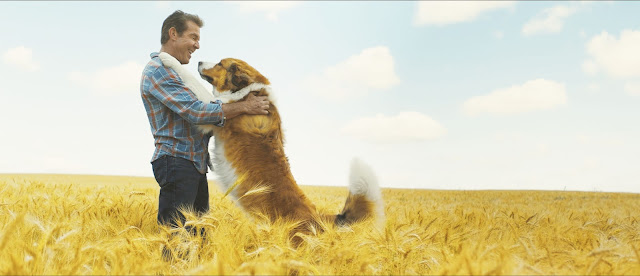A Dog’s Journey Review
(A version of this article originally appeared on kernelnow.com / mynewslike.com)
One of cinemas most unlikely franchises continues, as in the same year as the standalone A Dog’s Way Home comes the latest W. Bruce Cameron adaptation, A Dog’s Journey. This direct sequel to 2017’s A Dog’s Purpose resumes the story of “Boss Dog” Bailey: not just man’s best friend, but A man’s best friend. The forever friend of Ethan (Dennis Quaid), Bailey now graduates to four-legged guardian angel to his boy’s granddaughter CJ (Kathryn Prescott).
One of the more curious elements of A Dog’s Purpose was how despite following the life story of one boy and his dog, there was never a true explanation as to why their storyline never caught up to the modern age. Here, we get an explanation: where Ethan was a more traditional child of the American Dream, his granddaughter CJ is truly a 21st century baby. Over the 108 minute runtime, not only do we resume the evolution of a dog but also the progression of modern America – albeit, from a distance.
 |
| Yes, it really does get corny (source: Universal Pictures) |
The film does suffer from being removed from Ethan’s family home, the quintessential mid-Western family farm. A Dog’s Way Home also had its own unique setting, a largely Rockie mountain setting which allowed for picturesque and natural cinematography just like Ethan’s diner town did. CJ spends her youth in suburban Chicago and her adulthood in metropolitan New York, and neither city lives up to its usual cinematic iconography; the film moves quickly through any exterior shots to prolonged and basic indoor settings.
Unsurprisingly, one area where the visuals don’t disappoint is in the dogs themselves. What may surprise is how the latest Bailey-reincarnations aren’t exclusively the prototypical “cute” breeds – even the literally-named and slobbering Big Dog gets a moment in the spotlight. Maybe it’s just a ploy to get dog owners of all kinds to buy a ticket, but it’s certainly a fitting marriage to teenage CJ’s journey to accept herself and her own life for who and what it is.
 |
| Taking life one step at a time (source: Universal Pictures) |
The problem (if you can call it that) is how far these lessons are
reduced children. The moral delivery is spoon-fed, and the dialogue is
constantly cringe-worthy, even after CJ grows up. Josh Gad does a fine
job pretending to be a dog that can’t quite verbalise his wisdom, but
there’s only so many ways you can narrate the mysteries of both life and
another dog’s behind before the line between the two starts to blur.
Every character and location becomes a hand-drawn stereotype, as if
spelt out for the visually-limited canine stars of the film more than
the audiences watching it.
 |
| Taking things head on? Scratch that (source: Universal Pictures) |



Comments
Post a Comment